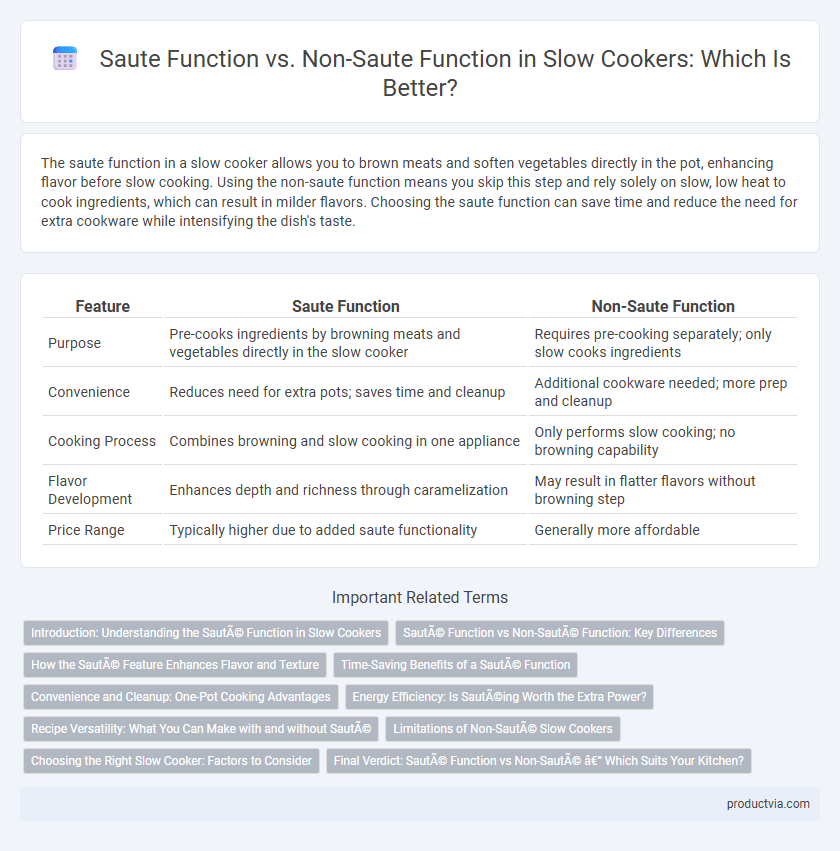The saute function in a slow cooker allows you to brown meats and soften vegetables directly in the pot, enhancing flavor before slow cooking. Using the non-saute function means you skip this step and rely solely on slow, low heat to cook ingredients, which can result in milder flavors. Choosing the saute function can save time and reduce the need for extra cookware while intensifying the dish's taste.
Table of Comparison
| Feature | Saute Function | Non-Saute Function |
|---|---|---|
| Purpose | Pre-cooks ingredients by browning meats and vegetables directly in the slow cooker | Requires pre-cooking separately; only slow cooks ingredients |
| Convenience | Reduces need for extra pots; saves time and cleanup | Additional cookware needed; more prep and cleanup |
| Cooking Process | Combines browning and slow cooking in one appliance | Only performs slow cooking; no browning capability |
| Flavor Development | Enhances depth and richness through caramelization | May result in flatter flavors without browning step |
| Price Range | Typically higher due to added saute functionality | Generally more affordable |
Introduction: Understanding the Sauté Function in Slow Cookers
The saute function in slow cookers allows users to brown and sear ingredients directly in the appliance, enhancing flavor development before the slow cooking process begins. This feature eliminates the need for a separate pan, saving time and reducing cleanup. Slow cookers without a saute function require pre-cooking on stovetops, which can add an extra step and complexity to meal preparation.
Sauté Function vs Non-Sauté Function: Key Differences
The Saute function in a slow cooker allows users to brown meats or soften vegetables directly in the pot, enhancing flavor through caramelization before slow cooking begins. Non-saute function slow cookers lack this capability, requiring separate stovetop preparation and additional cookware, which can cause extra cleanup and time. Choosing a slow cooker with a saute function streamlines meal prep by combining multiple cooking steps in one appliance, improving efficiency and taste depth.
How the Sauté Feature Enhances Flavor and Texture
The saute function in a slow cooker allows searing meats and vegetables directly in the pot, which caramelizes natural sugars and locks in juices, significantly enhancing flavor depth. This initial browning step creates complex Maillard reactions that a non-saute slow cooker function cannot replicate, resulting in richer, more robust taste profiles. Without sauteing, slow-cooked meals often lack the textured contrast and savory intensity that a quick sear imparts before the slow cooking process begins.
Time-Saving Benefits of a Sauté Function
The saute function in slow cookers significantly reduces cooking time by allowing ingredients to be browned directly in the pot before slow cooking, enhancing flavor and texture without the need for extra pans or steps. This feature eliminates the traditional pre-cooking stage on a stove, streamlining meal preparation and saving valuable time. Slow cookers without a saute function require separate cookware and additional cleanup, which can extend total cooking and preparation time.
Convenience and Cleanup: One-Pot Cooking Advantages
The saute function in a slow cooker allows for browning and sauteing ingredients directly in the pot, reducing the need for extra pans and minimizing cleanup. Non-saute slow cookers require pre-cooking on the stovetop, leading to additional cookware and more time spent washing dishes. Utilizing the saute feature streamlines one-pot cooking, enhancing convenience and simplifying the entire meal preparation process.
Energy Efficiency: Is Sautéing Worth the Extra Power?
Using the saute function in a slow cooker typically consumes more energy upfront but can reduce overall cooking time by browning ingredients directly in the pot, enhancing flavor without needing extra pans. Skipping sauteing saves the energy of the initial high heat but may require longer slow cooking, potentially offsetting energy savings. Evaluating energy efficiency depends on balancing the saute power usage against reduced slow-cooking duration and improved meal quality.
Recipe Versatility: What You Can Make with and without Sauté
The saute function in a slow cooker enhances recipe versatility by allowing you to brown meats and saute vegetables directly in the pot, developing deeper flavors before slow cooking. Without the saute function, recipes rely on pre-cooked or raw ingredients, which limits flavor complexity but still accommodates soups, stews, and casseroles. Utilizing the saute option expands your cooking range to include dishes needing a caramelized base, such as risottos and braised meats, that would otherwise require separate stovetop preparation.
Limitations of Non-Sauté Slow Cookers
Non-saute slow cookers lack the ability to brown or sear ingredients before slow cooking, limiting flavor development and texture enhancement in dishes. Without the saute function, users must rely on separate stovetop preparation, which can be inconvenient and time-consuming. This limitation reduces the overall efficiency and versatility of the appliance.
Choosing the Right Slow Cooker: Factors to Consider
The Saute function in a slow cooker allows for browning and searing ingredients directly in the pot, enhancing flavor and reducing the need for additional cookware. Slow cookers without the Saute function require pre-cooking on the stovetop, which can add time and complexity to meal preparation. Selecting a slow cooker with the Saute feature proves advantageous for convenience and improved taste profiles, especially when preparing recipes that benefit from caramelization.
Final Verdict: Sauté Function vs Non-Sauté – Which Suits Your Kitchen?
The saute function in a slow cooker allows for browning meats and vegetables directly in the pot, enhancing flavor and reducing overall cooking time by eliminating the need for a separate pan. Non-saute slow cookers require pre-cooking ingredients in another cookware, which can add preparation steps but may suit kitchens with limited appliance options. Choosing between saute and non-saute slow cookers depends on your cooking style; if convenience and deeper flavors are priorities, a saute function is ideal, whereas a non-saute cooker is suitable for simple, set-it-and-forget-it recipes.
Sauté function vs Non-sauté function for slow cooker Infographic

 productvia.com
productvia.com